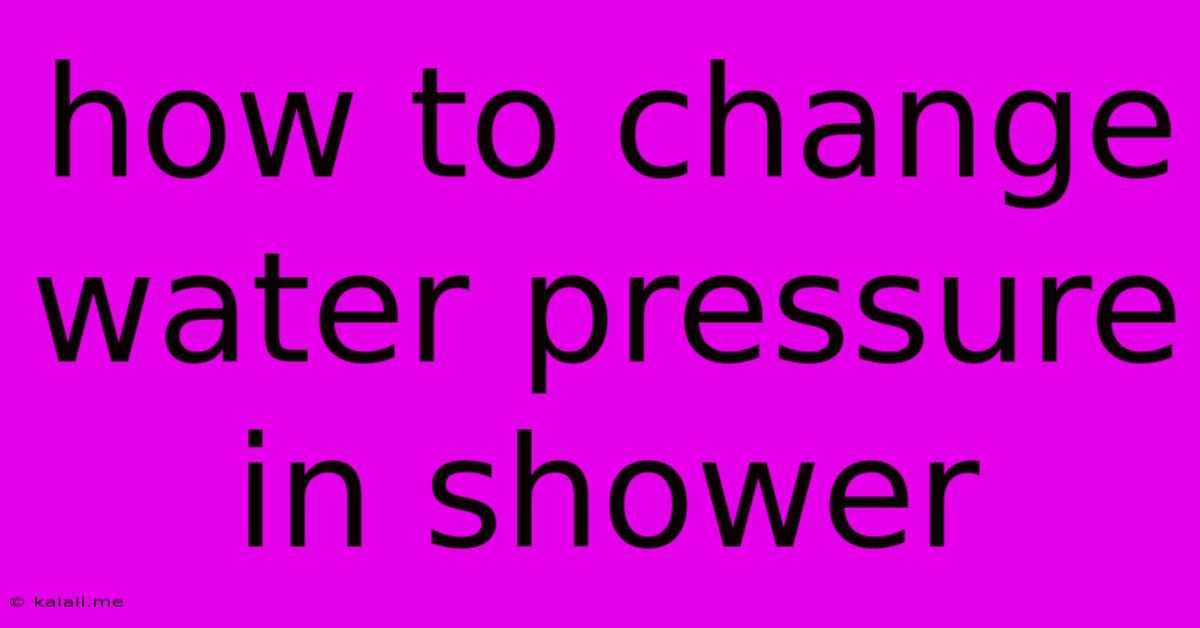How To Change Water Pressure In Shower
Kalali
May 21, 2025 · 4 min read

Table of Contents
How to Change Water Pressure in Your Shower: A Comprehensive Guide
Are you tired of a weak shower spray that barely rinses the shampoo from your hair? Or perhaps you're dealing with a shower that blasts you with water so forcefully it feels more like a pressure washer than a relaxing experience? Regardless of whether you have low water pressure or high water pressure in your shower, this comprehensive guide will walk you through the troubleshooting steps and potential solutions to achieve your ideal shower experience. We'll cover everything from simple fixes to more involved plumbing adjustments.
Understanding Shower Water Pressure Issues
Before diving into solutions, it's crucial to understand what causes fluctuating shower pressure. Low water pressure can stem from several issues, including:
- Low water pressure throughout the house: This points to a broader problem with your main water supply, potentially a clogged main water line or a problem with your water meter.
- Clogged showerhead: Mineral deposits and other debris can restrict water flow, leading to reduced pressure.
- Partially closed shut-off valve: Check the shut-off valves located under your sink or near the shower itself. Ensure they're fully open.
- Kinked or damaged shower hose: A kinked or damaged hose restricts water flow significantly.
High water pressure, on the other hand, can be equally problematic and might indicate:
- A problem with your main water pressure regulator: This device regulates the water pressure entering your home. A malfunction can lead to excessively high pressure.
- A faulty pressure-balancing valve: This valve is designed to maintain consistent water pressure even when other faucets are turned on. A malfunction might result in high pressure in the shower.
Troubleshooting and Solutions: Low Water Pressure
Let's tackle low water pressure first. Here's a step-by-step approach:
1. Check the Main Water Supply:
- Is the water pressure low throughout your house, or just in the shower? If it's house-wide, you might need a plumber to investigate the main water line.
2. Inspect the Showerhead:
- Clean the showerhead: Remove the showerhead and soak it in a solution of white vinegar and water to dissolve mineral deposits. Use a small brush or toothbrush to scrub away stubborn buildup. A pin can also be helpful to clear any smaller obstructions in the spray holes.
- Replace the showerhead: If cleaning doesn't solve the problem, consider replacing the showerhead with a new one. A low-flow showerhead might actually exacerbate the problem if your water pressure is already low, however, so carefully choose a replacement.
3. Examine the Shower Hose and Valves:
- Check for kinks: Carefully inspect the shower hose for any kinks that could restrict water flow.
- Check the shut-off valves: Ensure both the hot and cold water shut-off valves are fully open.
Troubleshooting and Solutions: High Water Pressure
Addressing high water pressure requires a more cautious approach, as it could indicate a serious plumbing issue.
1. Check the Pressure Regulator:
- If you have high pressure throughout the house, the pressure regulator might be malfunctioning. This is a job best left to a qualified plumber.
2. Inspect the Pressure-Balancing Valve:
- A faulty pressure-balancing valve can lead to inconsistent pressure in your shower. Again, a plumber should assess and repair or replace this valve.
3. Install a Pressure Reducing Valve:
- As a last resort, consider installing a pressure reducing valve. This is a plumbing task best left to a professional; however, understanding the potential need for one is a good first step in resolving the high pressure issue.
Choosing the Right Showerhead for Optimal Pressure:
Once you've addressed any underlying plumbing issues, consider selecting a showerhead that complements your water pressure. High-pressure showerheads are designed to disperse water effectively even with high water pressure, mitigating the forceful spray. Low-flow showerheads may be suitable if you are working with low water pressure and want to conserve water.
Remember, safety should always be your priority. If you're unsure about any of these steps, it's always best to consult a qualified plumber. They can diagnose the problem accurately and implement the correct solution, ensuring both efficient water usage and a satisfying showering experience.
Latest Posts
Latest Posts
-
See Ya In The Funny Papers
May 23, 2025
-
Rational Numbers And Natural Numbers Same Cardinality
May 23, 2025
-
Can U Use Physics2d In 3d Unity
May 23, 2025
-
Statsmodels Compute R2 Score On Test Set
May 23, 2025
-
Do Non English Names Come Last In Alphabetical Order
May 23, 2025
Related Post
Thank you for visiting our website which covers about How To Change Water Pressure In Shower . We hope the information provided has been useful to you. Feel free to contact us if you have any questions or need further assistance. See you next time and don't miss to bookmark.